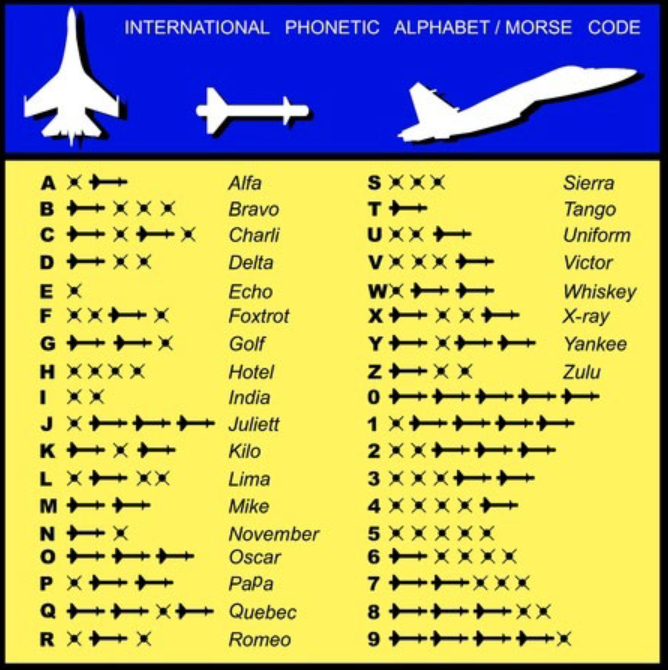The language of aviation came about from a need for safety. To avoid pilots and controllers mishearing each other and potentially creating an accident, a language of aviation terms and phrases were compiled in the Pilot/Controller Glossary.
To help avoid confusion with similar sounding consonants and numbers, in March 1956 the International Civil Aviation Organization (ICAO) adopted a standard phonetic alphabet for aviation use:
| LETTER | WORD | PHONIC (PRONUNCIATION) |
| A | Alfa | Al fah |
| B | Bravo | Brah voh |
| C | Charlie | Char lee |
| D | Delta | Dell tah |
| E | Echo | Eck oh |
| F | Foxtrot | Foks trot |
| G | Golf | Golf |
| H | Hotel | Ho tell |
| I | India | In dee ah |
| J | Juliet | Jew lee ett |
| K | Kilo | Key loh |
| L | Lima | Lee mah |
| M | Mike | Mike |
| N | November | No vem ber |
| O | Oscar | Oss cah |
| P | Papa | Pah Pah |
| Q | Quebec | Keh beck |
| R | Romeo | Row me oh |
| S | Sierra | See air rah |
| T | Tango | Tang go |
| U | Uniform | You nee form |
| V | Victor | Vik tah |
| W | Whiskey | Wiss key |
| X | X-ray | Ecks ray |
| Y | Yankee | Yang key |
| Z | Zulu | Zoo loo |
| NUMBER | WORD | PHONIC (PRONUNCIATION) |
| 1 | One | WUN |
| 2 | Two | TOO |
| 3 | Three | TREE |
| 4 | Four | FOW ER |
| 5 | Five | FIFE |
| 6 | Six | SIX |
| 7 | Seven | SEV EN |
| 8 | Eight | AIT |
| 9 | Nine | NIN ER |
| 0 | Zero | ZE RO |
| . | Decimal | DAY SEE MAL |
| 100 | Hundred | HUN DRED |
| 1000 | Thousand | TOU SAND |
ALPHABET MORSE CODE:

Many letters and phrases sound too similar, for example, the letters “p” and “b” may sound the same over the radio. So instead, pilots would say “papa” or “bravo”. Using the ICAO alphabet, pilots can communicate their location, approximate arrival time, any services required by crews, or the tail number of their plane.
All pilots, air traffic controllers, and flight dispatchers are required to know the aviation phonetic alphabet in order to more quickly and accurately relay information between each other. If a pilot needs to communicate information to the closest flight tower or to their destination, they will use the phonetic alphabet to avoid any confusion or miscommunication.
Today, the aviation alphabet is widely used and accepted and has become the standard for learning to become a pilot or work in the air travel industry. Understanding the words that are used for letters and numbers will help your communication be accepted no matter where you are traveling.
For example, pilots will not say a specific letter or number when speaking over their radio to dispatchers. They will instead say the word associated with the letters they are trying to communicate. The same is true for numbers. Instead of saying a specific number, the pilot or dispatcher will instead communicate each digit of the number separately.